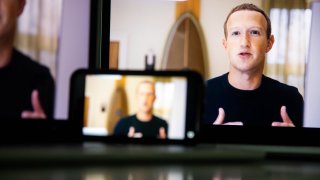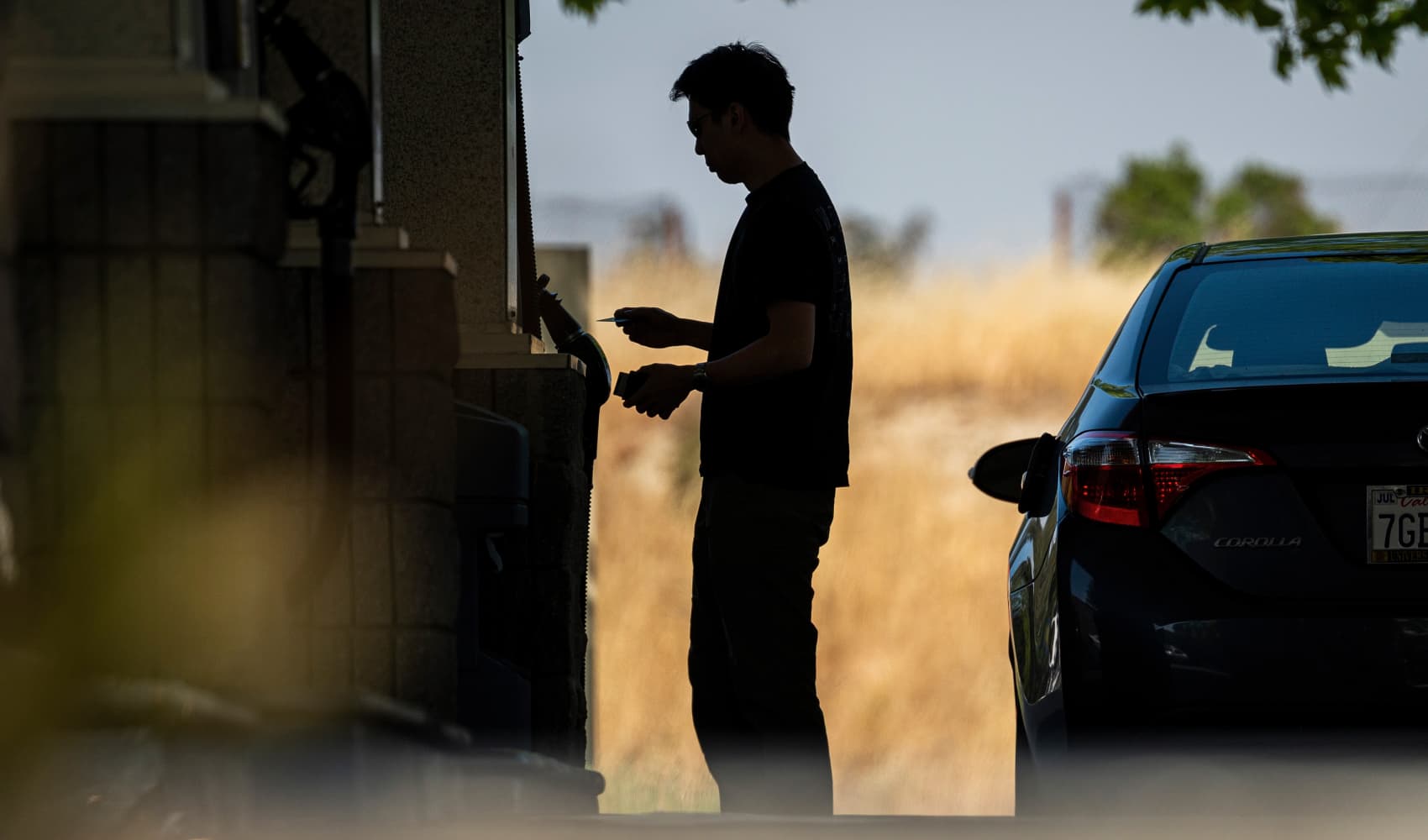
- Facebook's rebrand as Meta Platforms and Mark Zuckerberg's bet on the metaverse as the next big thing in social media technology doesn't change the fact that advertising is how the company makes the vast majority of its money.
- That means the way consumers experience ads today, such as the billboard ads from the real world that are encountered on roads or in venues, will be remade for the metaverse experience.
- Zuckerberg described the metaverse as an "embodied Internet" that, unlike the Internet of today, gives one a "feeling of presence" and brands from Nike to Disney and Gucci are working on efforts.
Imagine at a point in the near future, you are taking your daily trip through the metaverse when you encounter Colin Kaepernick. It's not the flesh-and-blood Colin Kaepernick, but a digital avatar of the former NFL star. As you interact with Kaepernick, Nike, Kaepernick's sponsor, becomes part of the experience. Whether you're a Nike fan or not, his presence at least affirms the brand's identity and story.
Advertising has always met the world where technology has taken its eyes and ears. If the first wave of advertising was print and billboards, followed by radio, and TV ushered in a new iteration in the 1950s built around the 30-second spot, an era lasted through the introduction of the World Wide Web in the 1990s.
But in the mid-2010s, the average time spent watching TV fell from 4.2 hours to the current 3.17 hours and that time is projected to continue falling through the decade. While it's not assured that less TV time means migration to the metaverse, a conceptual virtual world where people will interact with each other using headsets or smart glasses and virtual reality, many advertising executives are banking on it.
Get New England news, weather forecasts and entertainment stories to your inbox. Sign up for NECN newsletters.
The term "metaverse" dates back to Neal Stephenson's 1992 science-fiction novel "Snow Crash," in which humans, as avatars, interacted in a three-dimensional virtual space — to escape a dystopian reality. It has caught fire this year after Facebook rebranded itself as Meta Platforms, noting its goal is "to bring the metaverse to life and help people connect, find communities and grow businesses."
Meta CEO Mark Zuckerberg described the metaverse as an "embodied Internet" that, unlike the Internet of today, gives one a "feeling of presence."
Video game companies like Fortnite developer Epic Games and Roblox have planted a flag early in the metaverse trend. Nike — which has several patents related to selling products in the metaverse — recently created Nikeland in conjunction with Roblox, and seemingly every company is looking to do something.
Money Report
"Our efforts to date are merely a prologue to a time when we'll be able to connect the physical and digital worlds even more closely, allowing for storytelling without boundaries in our own Disney metaverse" said Disney CEO Bob Chapek on the company's third quarter earnings call.
"The metaverse is the next frontier just like social networking was when we got started," billionaire businessman Orlando Bravo, co-founder and managing partner of private equity firm Thomas Bravo, recently told CNBC. "It's investable and it's going to be very big."
Now, the question of how to monetize metaverse users' attention in this new form of media is top of mind. Advertising might have previously interrupted a user's media experience. A newspaper ad, for instance, ran on the same pages in which readers read news stories. Subsequent inventions like radio followed the same format: programming would be interrupted by audio ads. Later, TV would follow the same format.
Advertising executives sketched out a different approach for metaverse advertising.
The new billboard ad
In the first phase, these executives said, brands would merely erect digital billboards in the metaverse. The template for such advertising is in games like Tiki-Taka Soccer and FIFA Mobile, in which billboards for brands both increase awareness and, if the visitor is interested, lead to more information about the product.
"It's going to be very similar to what we have today in the real world," said Jason Velliquette, executive vice president of digital for marketing consultancy R3. He believes that there will be systems within the metaverse that let you produce and publish assets. "So in the same way that we have billboards on the side of the road or [out of] home signage, brands will still be able to buy these types of placements within a Metaverse environment or a 3D environment," he said.
That means, that if, say, a major financial services company like a Citibank wanted to set up a stand to teach financial education in the metaverse, it can. But in a virtual world, the brand might have better luck partnering with an influencer.
"Within Twitch, you have influencers who have these huge channels and following," said Velliquette. "You're going to still be able to follow these types of individuals or attend their seminars or go to their shows or go to their speaking engagements or things of that nature. And brands are going be able to partner and collaborate with these various influencers to really kind of make a splash within the metaverse space," he said.
Product placement
The pandemic forced more brands to experiment with the latest in camera technology and virtual fitting apps for clothing and cosmetics, and "virtual fashion" is an obvious target for early development and experimentation in the metaverse.
"When people walk around as avatars it's quite imaginable, that then your virtual version will dress up and use brands like Nike, Adidas, Balanchine, Balenciaga or Gucci or Levi's, doesn't matter," said Max Pinas, creative director for Dept, a global digital agency. "And so you will have virtual fashion," he said.
This past May, Gucci introduced a purse in Roblox that actually cost more than the item in real life.
Nike's virtual world called Nikeland within the Roblox platform is modeled after the company's headquarters. While it will feature different minigames for users to play like dodgeball and tag, Nike plans to have a digital showroom and include athlete and product integration.
In the past, when marketers place products in movies or TV shows, they use a product placement agency. In gaming and the metaverse, it works a bit differently. Generally, gaming has you work for goods. In World of Warcraft, for instance, you mine gold and when you get enough gold you can buy something.
The introduction of NFTs — non-fungible tokens — changes this equation. Suddenly a person (represented as a game avatar) can buy an NFT and virtually walk around different worlds with it.
Such cross-pollination inevitably leads to trouble. For example, last year in Fortnite it was possible to see both Marvel and DC Comics properties in the same location. "So you could see, let's say, somebody suited up as Batman and talking to the Avengers," Pinas said.
New universe for consumers
As marketers work out those branding boundaries, the technology keeps evolving. That's why, within a short time, a user will be able to interact with an embodiment of a brand, like Kaepernick for Nike.
Tiffany Rolfe, global chief creative officer of ad agency R/GA, said though the metaverse doesn't exist yet, it will provide a new universe of customers and environments to build within for entertainment companies like Disney, tapping existing intellectual property. And some of these new experiences will be similar to the 30-second TV spot. "It's a story that could play out over time across different platforms, different realities, stuff could happen in the real world, and then it connects you to something that's happening in the virtual world," Rolfe said.
"This last year of the pandemic, and how we engage with digital experiences has really opened our eyes to what's possible. Experiences are going to be a big space where brands will create [events] to bring people in and get the scale there," she added.
Some advertising executives say successful efforts will need to take into account that the metaverse, by its original definition, is a realm inside of which the individual escapes the real world. That means brands shouldn't create what looks at all like advertising as we know it, and what will come across as real in the virtual world will be different.
"The time of phoning it in is over, and brands must redefine their approaches to audience engagement," said Lewis Smithingham, Media.Monks' director of creative solutions. "In the metaverse, brands need to strike a balance between being present and being authentic by providing utility and meaning for people through creativity and technological innovation. In short, brands must create experiences people actually want."






